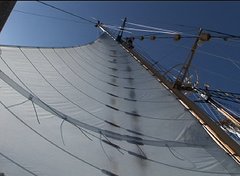
June 1, 2007. Aboard the SSV Robert C. Seamans, near Kingman Reef. We’ve made it up to Kingman Reef, the northernmost point along the Line Islands. [The tiny spit of land is an unincorporated territory of the United States, and is administered by the U.S. Navy.] Bringing the Seamans within 0.15 nautical miles of this barren spit of reef is a remarkable moment for our program. Its also a bit of a tense experience. We tried to sail here during Stanford@SEA 2003, but did not make it into the channel due to squalls and cloudy weather, which made viewing of coral heads that bring up the bottom rapidly to 5 fathoms (one fathom is about six feet), and the disconcerting feeling that the charts were off.
This year, under the brilliant leadership of Captain Phil Sacks, we sailed into the reef on a spectacular sunny day. This was our Everest, taking this ship into this reef and allowing research to be conducted. It was not easy by any stretch of the imagination.
 The coral cover beneath the sea surrounding the spit of land is astounding -- almost 100% in all places we’ve looked. Compared to any place in the Line Islands, the visibility is clearer and the colors of the coral reef more brillant, with the colors enhanced by giant clams everywhere.
The coral cover beneath the sea surrounding the spit of land is astounding -- almost 100% in all places we’ve looked. Compared to any place in the Line Islands, the visibility is clearer and the colors of the coral reef more brillant, with the colors enhanced by giant clams everywhere.We quickly conducted transects for predators and found the reef rich with large snappers, some groupers; black tip, gray reef and white tip sharks abounded. The herbivore fish include some of the species we’ve rarely seen, such as schools of moorish idols (Zanclus cornutus -- "Crowned Scythe"). Last night and into the early morning we had “shark night”. By chumming with leftover parts from our successful fishing endeavors, we were able to see about 16 gray reef sharks, some aggressively pursuing prey that we had attracted to our lights. We fed the sharks from the ship so that we could examine them up close. It was squally and rainy, and diligent work by the crew kept us safely away from the reef edge.
We spent the early morning using our small Avon inflatable boat to make landfalls on the spit of land. Here we were able to set foot on what I realized must be one of the most desolate places on Earth. A ghostly shipwreck loomed close to us, and we all took a picture near it. As I glanced at our ship and the shipwreck, I could not help but wonder what a forlorn situation it would be to be stranded here on a tiny spit surrounded by a shark-filled reef.
We collected two large trash bags of assorted plastics, line and buoys that may have drifted thousands of miles to land here. At noon, with a brisk wind, we sailed out of the reef for Hawaii. A 900 nautical-mile, 11-day journey over the ocean lies ahead. -- Barb Block, chief scientist


No comments:
Post a Comment